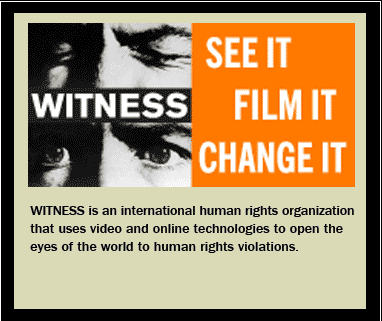Sam Gregory's training material, "Video Advocay Guides, Toolkits, and Resources", in the toolkit section of the Hub helps people learn how to film, edit and distribute video in a effective and ethical manner to promote social, political, and economic change. The video advocacy guide is a powerful medium that provides people with the necessary tools to tell their own story. It provides an alternative to mainstream media that often neglects and misrepresents certain marginalized communities.
The guide provides four videos explaining in a direct simple manner how to prepare and gather meaningful material before, during and after filming. The rise of technology has allowed people to capture instant footage of protests, police brutality and other eye witnessing forms of media but many time these images stay stored in memory cards without ever reaching a public audience. The video advocacy guide provide great ideas on how to use these visual images and videos to promote awareness and empower people to take action on certain issues. The video advocacy guide understands the importance of letting people tell their own stories by advising the person filming to let the individual affected by the issue to talk about it rather than having himself or herself explain it on their behalf. This is a critical aspect of creating videos for social change. Many times the authority of a reporter or filmmaker takes away the agency people have in telling their own stories and often misrepresents the people or issues discuss.
Along with issues of misrepresentation in filming the guide addresses ways to ethically edit video to provide a truthful experience that does not create a false sequence of cause and effects. The guide emphasizes the importance of engaging your audience into some sense of action whether by conveying a sense of hope or outrage that will mobilize people to advocate for a particular issue. It advises filmmakers for advocacy to constantly re-access their risk of filming controversial issues for those who appear on camera, their organization, or themselves. Advocacy videos must be constantly re-access in order to ensure that people who need to be protected are being protected and the video is framed in an ethical truthful manner that conveys urgency for action and engages its audience to make a difference. This particular form of news reporting challenges the mainstream media that often fails to provide news in a transparent and truthful manner due to its underlying political agendas.
The guide provides four videos explaining in a direct simple manner how to prepare and gather meaningful material before, during and after filming. The rise of technology has allowed people to capture instant footage of protests, police brutality and other eye witnessing forms of media but many time these images stay stored in memory cards without ever reaching a public audience. The video advocacy guide provide great ideas on how to use these visual images and videos to promote awareness and empower people to take action on certain issues. The video advocacy guide understands the importance of letting people tell their own stories by advising the person filming to let the individual affected by the issue to talk about it rather than having himself or herself explain it on their behalf. This is a critical aspect of creating videos for social change. Many times the authority of a reporter or filmmaker takes away the agency people have in telling their own stories and often misrepresents the people or issues discuss.
Along with issues of misrepresentation in filming the guide addresses ways to ethically edit video to provide a truthful experience that does not create a false sequence of cause and effects. The guide emphasizes the importance of engaging your audience into some sense of action whether by conveying a sense of hope or outrage that will mobilize people to advocate for a particular issue. It advises filmmakers for advocacy to constantly re-access their risk of filming controversial issues for those who appear on camera, their organization, or themselves. Advocacy videos must be constantly re-access in order to ensure that people who need to be protected are being protected and the video is framed in an ethical truthful manner that conveys urgency for action and engages its audience to make a difference. This particular form of news reporting challenges the mainstream media that often fails to provide news in a transparent and truthful manner due to its underlying political agendas.

This is a very relevant entry to the class discussion that highlights a specific resource that benefits everyone in the class and provides analysis of Witness's specific tips for shooting and editing from the standpoint of thinking about a reporter's identity and the credibility of footage.
ReplyDeleteI did take the liberty of breaking your entry into three shorter paragraphs, since it is very important to "chunk" online information for maximum readability. I might also suggest structuring your prose around more relevant links as well.
ReplyDelete